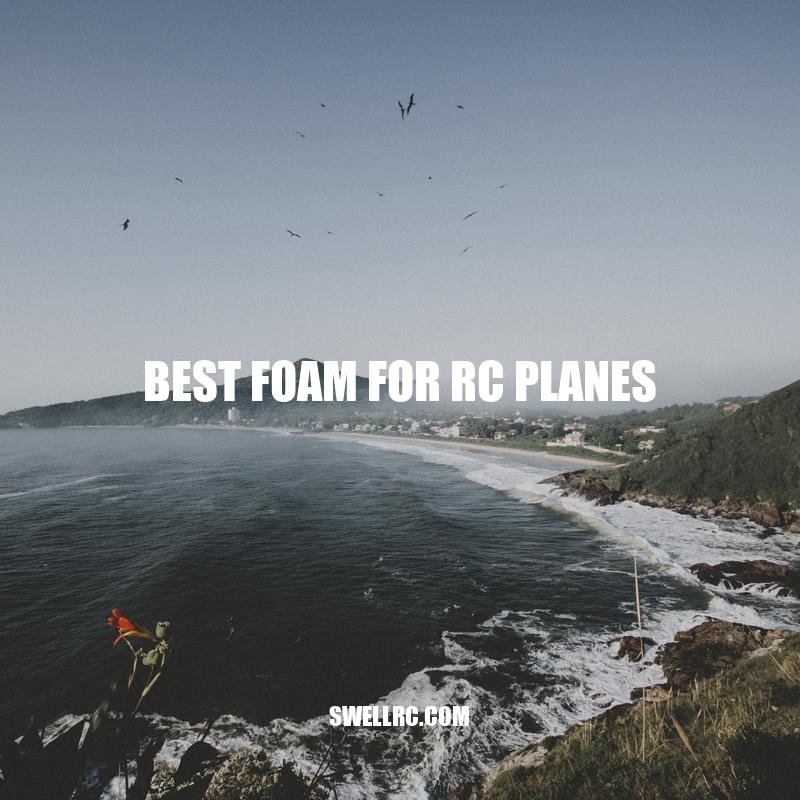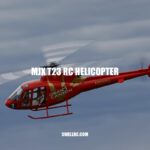Choosing the Best Foam for RC Planes
RC planes are becoming increasingly popular among enthusiasts of all ages and backgrounds. These miniature airplanes are a great way for hobbyists to experience the thrill of flying without the high cost and danger associated with traditional aircraft. However, just like any other hobby, building an RC plane requires a certain level of knowledge and skill. One of the most important factors to consider when constructing an RC plane is the type of foam to use. The right foam can make a tremendous difference in the durability, weight, and stability of the aircraft. There are several different types of foam available on the market, each with its own unique characteristics and benefits. This article will provide an overview of the best foam options for RC planes, and help readers to choose the right one based on their specific needs and preferences.
Types of Foam for RC Planes
There are three main types of foam that are commonly used for RC planes. These include Expanded Polystyrene (EPS), Extruded Polystyrene (XPS), and Expanded Polypropylene (EPP). Each type of foam has its own unique characteristics and benefits. Here’s a closer look:
- Expanded Polystyrene (EPS): This is the most common type of foam used in RC planes. It is lightweight and durable, making it an ideal choice for beginners. EPS foam is also relatively inexpensive and easy to work with.
- Extruded Polystyrene (XPS): XPS foam is slightly denser than EPS foam, which makes it stronger and more resilient. This type of foam is ideal for more advanced RC planes that require greater stability and support. XPS foam is also more moisture-resistant than EPS foam, which can be a valuable asset for aircraft that are used in wet or humid environments.
- Expanded Polypropylene (EPP): EPP foam is the most durable and flexible foam option for RC planes. It can withstand impacts and rough landings, making it a great choice for those who are learning to fly or want to experiment with more acrobatic maneuvers. EPP foam is also lightweight and easy to shape, which makes it ideal for building custom planes and experimenting with new designs.
For those looking to purchase foam for their RC plane, there are many websites and online stores that offer a variety of options. Some popular options include HobbyKing, Flite Test, and Motion RC. Additionally, many local hobby stores carry foam for RC planes, and can often provide valuable advice and guidance on selecting the best type of foam for your specific needs.
What kind of foam board for RC planes?
Depron Aero is the recommended foam board for RC planes because it is specifically manufactured for RC use. It is a closed-cell extruded polystyrene that is lightweight and durable. Depron is also marketed for arts projects and can be used for RC modeling. It is sold as wall insulation and flooring substrate. For more information on Depron Aero and other RC foam boards, check out RC online stores and RC modeling websites.
EPS foam is a widely used foam type for RC planes. Here are some of the characteristics, advantages, and disadvantages of EPS foam:
- Definition: EPS foam is a lightweight, closed-cell foam that is made from expanded polystyrene beads.
- Characteristics: EPS foam has a fairly low density, typically around 1 lb per cubic foot. It is relatively soft and flexible, and is known for its good insulating properties. The foam has a slightly rough texture on one side and a smooth surface on the other, which allows it to easily adhere to other materials.
- Advantages: EPS foam is widely available and affordable, making it a popular choice for beginners and those on a budget. It is also easy to cut and shape, which allows for a lot of design flexibility. Additionally, EPS foam can be easily painted or coated with a variety of materials to enhance its appearance and durability.
- Disadvantages: EPS foam is not as strong or rigid as some other types of foam, which can limit its suitability for larger or more advanced RC plane models. Additionally, EPS foam can be prone to damage from impacts and rough handling, which can shorten its lifespan and require more frequent repairs or replacements.
When shopping for EPS foam, there are many different brands and options to choose from. Some popular options for foam sheets and blocks include Foam Factory, US Foam, and Fibre Glast. It’s important to choose a foam that is the right thickness and density for your specific needs, so be sure to consult RC plane guides and expert advice before making a purchase.
To provide an overview of the different types of foam available for RC planes, here is a comparison table:
| Foam Type | Density | Strength | Flexibility |
|---|---|---|---|
| EPS | Low | Low | High |
| XPS | Medium | High | Low |
| EPP | Low | High | High |
What is EPS foam used for?
EPS foam is commonly used in the packaging and construction industry due to its lightweight and rigid nature. It is cost-effective and provides energy-efficient insulation. It also serves as a cushion for transporting shock-sensitive goods. We can find EPS foam on product packaging or as insulation material in buildings.
Extruded polystyrene (XPS) foam is considered by many to be the best foam for RC planes. XPS foam is known for its high strength, toughness and rigidity, which makes it well-suited for larger or more advanced RC plane designs. XPS foam is a rigid, closed-cell foam that is made by mixing polystyrene granules with blowing agents and then extruding the mixture through a die. It has a homogeneous structure and a smooth, flat surface, which makes it easy to cut and shape.
XPS foam is also highly resistant to water and moisture. This makes it an excellent choice for RC planes that will be flown in wet or humid conditions. Additionally, XPS foam has good insulating properties, which can help improve the stability and aerodynamics of the plane.
Some of the most popular brands of XPS foam for RC planes include Dow Styrofoam, Owens Corning Foamular, and Foam Factory. It’s important to choose a foam that is the right thickness and density for your specific needs, so be sure to consult RC plane guides and expert advice before making a purchase.
While XPS foam is one of the strongest and most durable foam types available, it can be more difficult to work with than other types of foam. XPS foam requires specialized cutting tools and techniques to achieve precise shapes and angles. Additionally, XPS foam is heavier and more rigid than some other types of foam. This makes it less suitable for smaller or more lightweight RC planes.
To better understand the differences between foam types, here is a comparison table:
| Foam Type | Density | Strength | Flexibility |
|---|---|---|---|
| EPS | Low | Low | High |
| XPS | Medium | High | Low |
| EPP | Low | High | High |
What is the difference between Styrofoam and EPS foam?
Styrofoam is made from extruded polystyrene (XPS), while EPS foam blocks are made from expanded polystyrene. This is the main difference between the two foam materials.
Manufacturing Process and Techniques
The manufacturing process and techniques used to create foam can have a significant impact on the strength, quality and suitability of the final product. Here are some things to keep in mind when choosing the best foam for RC planes:
- Extrusion: Most foam types are made by extruding (forcing through a die) a mixture of plastic granules and gas or blowing agents. However, some manufacturers may use different additives or processes to achieve specific results, such as improved strength or flexibility.
- Mold injection: Some foam types, such as EPP foam, may be made by injecting melted plastic into a mold. This can help create a more uniform and consistent product.
- Cutting and shaping: Once the foam has been manufactured, it needs to be cut and shaped into the desired dimensions for your RC plane. This can be done using specialized cutters or saws, but it’s important to use the right techniques and ensure the foam is properly supported to prevent damage.
- Fine foam: Some manufacturers may produce “fine” or high-quality foam that has smaller and more consistent cells than standard foam. This can improve the strength and durability of the foam, as well as enhance its overall appearance.
- Proper handling: To prevent damage to the foam, it’s important to handle and store it properly. This may include using protective packaging during shipping and storing the foam in a cool, dry location away from direct sunlight and extreme temperature fluctuations.
To get the best results with your foam, be sure to follow manufacturer recommendations and use proper techniques for cutting, shaping and handling the foam. Some websites, such as RCgroups.com and Flitetest.com, offer tutorials, guides and forums where you can learn more about foam manufacturing and RC plane building techniques.
What are the techniques for foam production?
Foam can be produced commercially using two basic methods: spray and pour. The pour method is used for all types of foams, while the spray method is limited to rigid foams. The most popular and versatile technique for rigid urethane foam application is pouring-in-place. For more information on foam production techniques, visit manufacturing websites such as foamcraftinc.com or chemical supply companies such as BASF.com.
How to Choose the Best Foam for Your RC Plane
Choosing the right foam for your RC plane can be a crucial decision, as it can affect the performance, durability and overall enjoyment of your model. Here are some factors to consider when selecting a foam:
- Density: Foam density refers to the weight of a given volume of foam, usually expressed in pounds per cubic foot (lbs/ft³). A higher density foam may be stronger and more rigid, but also heavier. A low-density foam may be lighter and more flexible, but also weaker. Consider the weight of your RC plane and the intended use.
- Stiffness: The stiffness of the foam determines how easily it will bend or compress under stress. A stiffer foam may be more stable, but also more brittle and prone to cracking. A more flexible foam may be better for shock-absorption and durability, but could affect the precision and handling of your RC plane.
- Compatibility: Consider the type of RC plane you want to build and choose a foam that is suitable for the design and specifications. Different foams may be better for different parts of the plane, such as fuselage, wings, tail, etc. Additionally, some foams may be more compatible with certain adhesives or coatings.
- Budget: The cost of foam can vary depending on the type, quality and quantity. Consider your budget and how much foam you will need for your RC plane.
- Experience level: If you’re a beginner at RC plane building, you may want to choose a foam that is easy to work with and forgiving of mistakes. More experienced builders may prefer more challenging foams that offer better performance and customization.
There are many websites and forums where you can find recommendations, reviews and advice on choosing foam for RC planes. Some popular sites and brands include:
| Website/Brand | Description |
|---|---|
| RCgroups.com | A large and active community of RC plane builders and enthusiasts. Offers guides, tutorials, forums, classifieds and more. |
| Flitetest.com | A website and YouTube channel focused on building and testing RC planes. Offers tutorials, reviews, forums, merchandise and more. |
| Dow Chemical | A major manufacturer of foam products, including EPS, XPS and EPP foam. Offers technical data, specifications, product information and more. |
| Foam Factory | A distributor of foam products, including foam sheets, blocks, balls, and custom shapes. Offers product descriptions, ordering information, tutorials, and more. |
Which foam is best for RC planes?
Depron foam is a popular choice for smaller RC planes that require curved shapes. Meanwhile, EPP foam is a flexible option commonly used for indoor ready-to-fly RC planes. On the other hand, solid foam options such as foam board and Blucor Fanfold foam are ideal for slightly heavier electric RC planes. For more information, you can refer to the sources mentioned in the statement.
Conclusion
In conclusion, choosing the best foam for your RC plane depends on several factors, including density, stiffness, compatibility, budget, and experience level. Each type of foam has its pros and cons, so it’s important to do your research and consider your priorities. Moreover, it’s important to select a foam that is suited to the plane you are building, and your level as an RC plane builder. Make sure you handle the foam effectively and follow the appropriate techniques to prevent damages.
By keeping these factors in mind and experimenting with different types of foam, you can find the perfect fit for your RC plane. Don’t be afraid to ask for recommendations from experts, browse online resources, and try out various products. With the right foam, you can ensure better performance, durability and safety for your RC plane.



